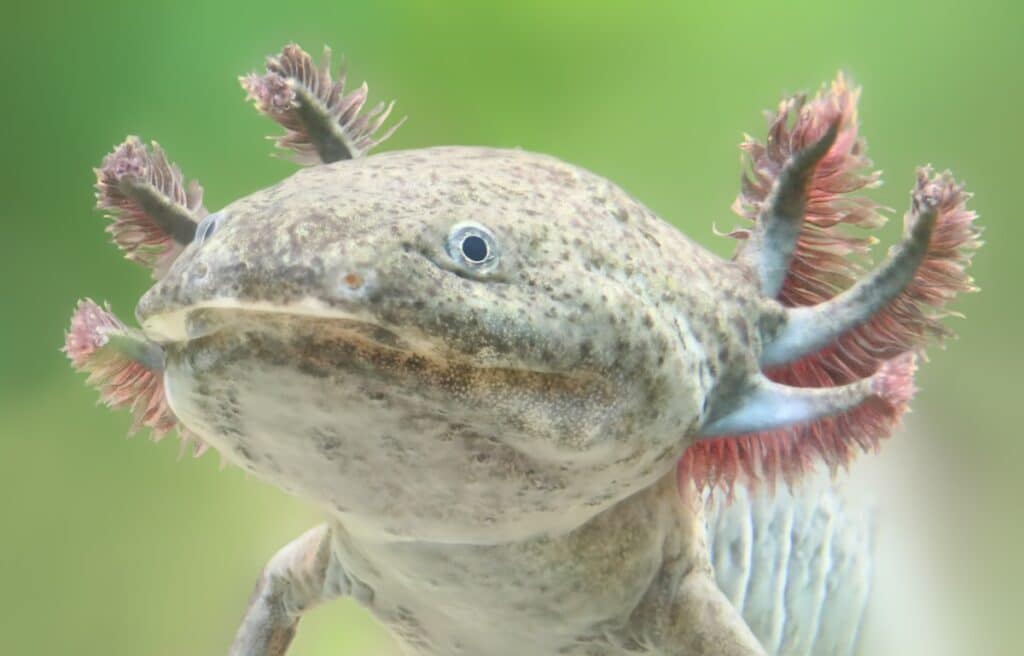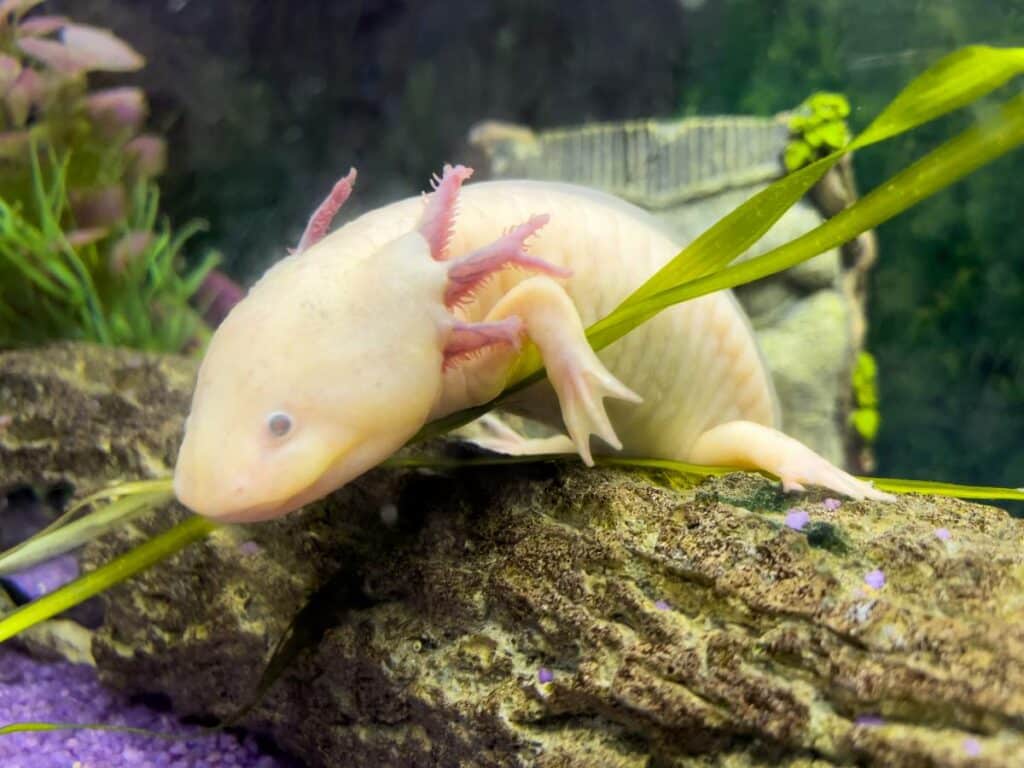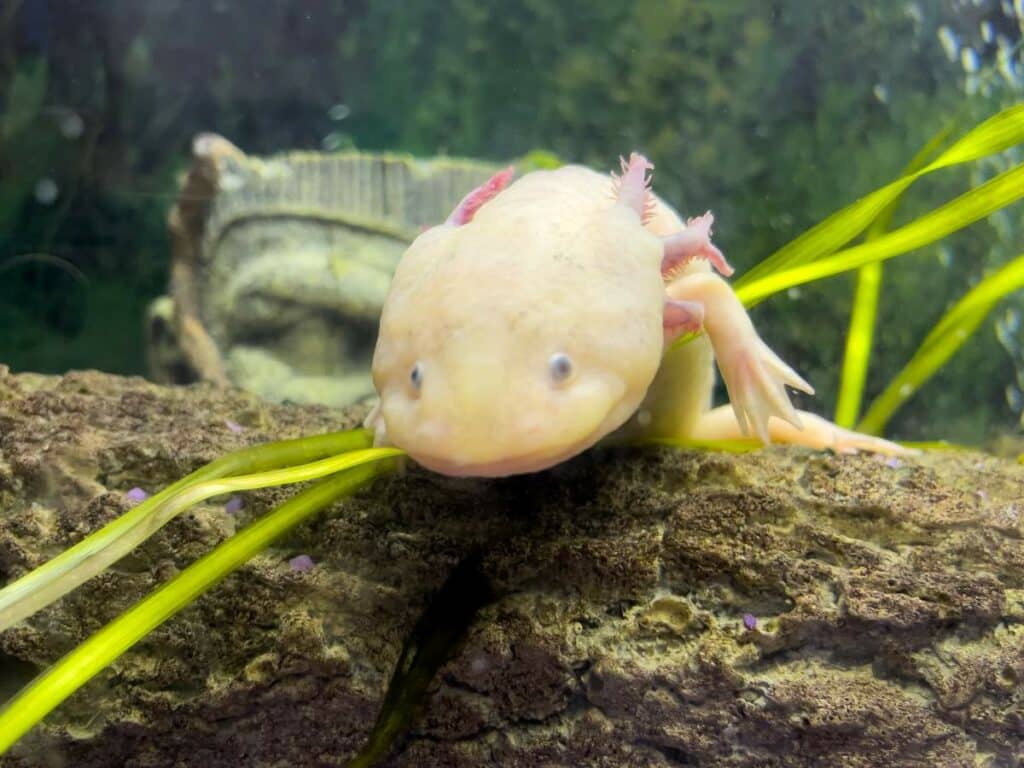the essentials in brief
A real axolotl costs between 25 and 150 euros, depending on color and size. You can buy him from a reputable breeder or at a specialty store. Read more here...
Axolotls can also be kept by novice owners if they are willing to delve deeply into the needs of these special animals. Axolotls are not ordinary pets and require special care and a suitable aquarium. Read more here...
Axolotls can be kept in an aquarium, but not in a regular fish tank. You need a large tank with an area of at least 80 x 40 cm, cold water (16 to 18 degrees Celsius), a fine sand or gravel bottom, a good filter, plenty of hiding places and no heating or lighting. Read more here...
You may have heard of an axolotl or seen one in the aquarium. But what exactly is an axolotl? And how can you keep it species-appropriate? In this blog post you will learn everything about these extraordinary animals.
The Axolotl: A Natural Wonder from Mexico

The axolotl is a fascinating animal that is only found in a few lakes in Mexico. It belongs to the amphibian family and is related to the newts and salamanders. But he has one peculiarity: he remains a larva all his life and does not develop into an adult animal with lungs. This is called neoteny.
The axolotl lives in Fresh water and prefers cool temperatures between 16 and 18 degrees Celsius. Its natural habitat is the lakes of Xochimilco and Chalco, which were considered sacred by the Aztecs. However, these lakes are under severe threat from Mexico City expansion, agriculture and industry. Water is becoming scarcer, dirtier and warmer, which harms the axolotl. Also, many alien fish and amphibians are introduced to eat or compete with the axolotl. Therefore, the axolotl is threatened with extinction in its homeland.
The axolotl feeds of live or frozen worms, insect larvae or small fish, which he devours with his big mouth. It has no teeth, just gristle teeth that it uses to hold onto its prey. It can also eat plants, but rarely does so.
Tip: If you want to keep an axolotl as a pet, you should do your research and preparation before you buy one. An axolotl needs a special attitude in the aquarium that offers plenty of space, cool water, clean substrate and enough hiding places.
The axolotl reproduces in water by external fertilization. The female lays up to 1000 eggs, which the male sprays with his sperm. The eggs stick to plants or stones and hatch after about two weeks. The young already look like small axolotls and already have gills. They grow quickly and are sexually mature after about six months.
The axolotl is a very interesting animal that fascinates many researchers. Not only can it keep its gills, but it can also regrow lost body parts such as a tail, legs, or even parts of the heart or brain. That's called regeneration. So we can learn a lot from the axolotl about healing from injuries.
However, the axolotl is also a popular pet that is kept in many aquariums. However, it needs special care and a lot of space. If you decide to get an axolotl, you should be well informed and act responsibly. Because the axolotl is a unique creature that needs to be valued and protected.
What are the dangers of the axolotl?
Unfortunately, the axolotl is critically endangered in its natural habitat. The reasons for this are varied and mainly due to people. Here are some of the biggest threats to the axolotl:
- The Destruction and pollution of its habitat through the expansion of Mexico City, agriculture and industry. This makes the water scarcer, dirtier and warmer, which harms the axolotl.
- The introduction of alien fish or amphibians that will eat or compete with the axolotl. These include, for example, carp, trout or African clawed frogs.
- Overfishing and illegal trade in the axolotl as a delicacy or medicinal. The axolotl is sold in local markets or smuggled abroad.
- Genetic impoverishment and inbreeding of the axolotl, which affect its adaptability and health. Populations are becoming smaller and more isolated.
Tip: If you want to feed the axolotl, you should give it live or frozen worms, insect larvae, or small fish. Avoid dry food or pellets that are unsuitable for the axolotl. They can lead to digestive problems or even death.
In order to protect the axolotl, there are various initiatives and projects that are committed to its conservation. These include, for example, the Axolotl Conservation Project or the Ambystoma Genetic Stock Center. These organizations attempt to conserve the axolotl's habitat, monitor its population, and preserve its genetic diversity.
How can you hold an axolotl?

An axolotl is no ordinary pet and needs special care in the aquarium. If you decide to buy an axolotl, you should inform yourself and prepare well before you buy it. Here are some important points to keep in mind:
Note: The axolotl is critically endangered in its natural habitat. The reasons for this are the destruction and pollution of its habitat, the introduction of foreign predators and the illegal trade in the axolotl. If you want to protect the axolotl, you can get involved in various initiatives and projects that work to preserve it.
- The Aquarium should hold at least 100 liters and 50 liters more for each additional axolotl. Because the axolotl needs a lot of space to swim and hide. It also produces a lot of excretions that pollute the water. An aquarium that is too small or too full can lead to stress, illness and aggression.
- The water should be cool (16 to 18 degrees Celsius), clean and well filtered. Avoid direct sunlight or heaters that can heat the water too much. Axolotls are adapted to cool temperatures and can suffer or even die if the temperature gets too high. Water should be changed regularly and tested for proper pH, nitrite, nitrate and ammonia levels. A good filtration system is essential to keep the water clear and clean.
- The The substrate should consist of fine sand or gravel, which cannot be swallowed. Avoid sharp or pointed decorations that could injure the axolotl. Axolotls are very curious and will happily eat anything they find. Therefore, make sure that the substrate does not have any sharp edges or is too big to be swallowed. This could lead to injury or bowel obstruction.
- Offer dem Axolotl enough hiding places such as caves, roots or plants. This allows him to withdraw when he feels stressed or threatened. The axolotl is a shy animal that likes to hide. In order to feel comfortable, it needs enough hiding places in the aquarium. Caves made of clay, wood or stone that are large enough for the axolotl are suitable for this. Roots or plants can also offer good hiding places. But make sure that the plants are robust and cannot be eaten by the axolotl.
- Feed the axolotl live or frozen worms, insect larvae or small fish. Avoid dry food or pellets, which can cause digestive problems. The axolotl is a carnivore that likes to hunt live prey. For example, you can feed him earthworms, mosquito larvae, tubifex, or small fish like guppies. You can buy these in pet shops or breed them yourself. You can also feed frozen worms or fish that you thaw beforehand. However, avoid dry food or pellets, which are not suitable for axolotls. They can cause bloating, constipation or diarrhea. Feed the axolotl about two to three times a week and remove leftover food from the aquarium.
- Only keep the axolotl with others of a similar size. Other fish or amphibians can attack or be eaten by it. The axolotl is a loner and doesn't need company. However, it can be kept with other axolotls if they are of a similar size and have enough space. Just make sure they don't bite or eat each other. This can happen when they are hungry or bored. Don't keep the axolotl around fish or amphibians that aren't their own species. You can disturb, injure or infect him. He might also see them as food and try to eat them.
Why the axolotl deserves our admiration and protection
The axolotl is a fascinating water monster from Mexico with many special features. It remains a larva throughout its life, is capable of regeneration and has exceptional coloring. But he is also a demanding animal that needs special care in the aquarium. And he's an endangered animal that needs our help to survive. If you are interested in an axolotl, you should be well informed and act responsibly. Because the axolotl is a unique creature that needs to be valued and protected.



